
Gelderland, also known as Guelders in English, is a province of the Netherlands, occupying the centre-east of the country. With a total area of 5,136 km2 (1,983 sq mi) of which 176 km2 (68 sq mi) is water, it is the largest province of the Netherlands by land area, and second by total area. Gelderland shares borders with six other provinces and the German state of North Rhine-Westphalia.

Maurice of Orange was stadtholder of all the provinces of the Dutch Republic except for Friesland from 1585 at the earliest until his death in 1625. Before he became Prince of Orange upon the death of his eldest half-brother Philip William in 1618, he was known as Maurice of Nassau.

Aalten is a municipality and a town in the eastern Netherlands. The former municipalities of Bredevoort (1818) and Dinxperlo (2005) have been merged with Aalten.
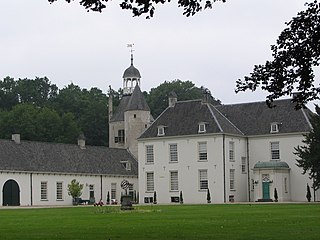
Terborg is a small city in the Dutch province of Gelderland, in the Achterhoek region in the east of the Netherlands. It is located in the municipality of Oude IJsselstreek. The city lies about 7 km southeast of Doetinchem. The population is about 4600 inhabitants.

Vriezenveen is a town in the municipality of Twenterand in the Dutch province of Overijssel. The population was 13,800 on January 1, 2020.

Oude IJsselstreek is a municipality in the province of Gelderland, in the eastern Netherlands. It was established on 1 January 2005 by a merger of the former municipalities of Gendringen and Wisch.
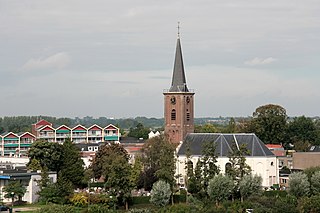
Mijdrecht is a town in the Netherlands with about 16,000 residents. It is located in the municipality of De Ronde Venen, about 7 kilometres (4.3 mi) west of the main A2 motorway, between Utrecht and Amsterdam.

Bredevoort is a small city with city privileges of about 1600 inhabitants in the municipality of Aalten, Netherlands. It is between the towns of Aalten and Winterswijk.
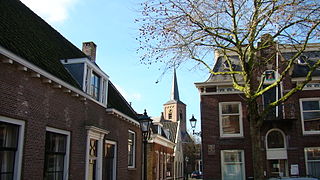
Zwammerdam is a village in the Dutch province of South Holland along Oude Rijn river. It is a part of the municipality of Alphen aan den Rijn, and lies about 6 km southeast of Alphen aan de Rijn. The name derives from a dam built in the Rhine river in 1165 AD by Count Floris III of Holland, to protect the land stream downwards from floods.

Maarten van Rossum was a military tactician of the duchy of Guelders who became field marshal in the service of Charles, Duke of Guelders. He was greatly feared outside his home country for the ruthless manner in which he waged war. In a long career, he often put his motto ""Blaken en branden is het sieraad van de oorlog" into practice. His way of waging war was quite similar to that of his Italian colleagues, the condottieri, and was characterized by guerrilla-like tactics, in which the civilian population was spared even less than was usual in his time.

Arum is a village in the Súdwest-Fryslân municipality in the Dutch province of Friesland. It is about 5 km southeast of the city of Harlingen.

De Heurne is a village in the municipality of Aalten, near Dinxperlo, Province of Gelderland, in the east of the Netherlands.

Velzeke-Ruddershove is a double village in the Denderstreek in the province of East Flanders in Belgium, currently part of the municipality of Zottegem.

Simon Berman was the mayor of Kwadijk, Middelie, Warder, Schagen, Bedum, and Alblasserdam in the Netherlands. He was the first mayor of Kwadijk, Middelie, and Warder to actually live in one of those villages. As a popular mayor of Schagen, he handled a double murder case that drew national media attention and advanced a professional school and regional light rail and canals. In Alblasserdam, he addressed the local impacts of World War I. Berman is also known for his association with Christian anarchism.
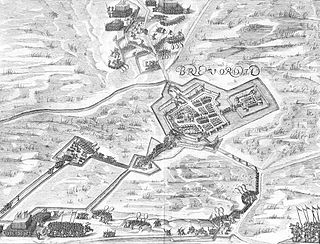
The siege of Bredevoort in 1597 was a siege of Bredevoort by the military forces led by Maurice of Nassau, Prince of Orange, during the Eighty Years War and the Anglo-Spanish War. The siege lasted from 1 October until 9 October; after that day Bredevoort was occupied by the besiegers. The siege was part of a campaign during which Maurice conquered the cities Turnhout, Alphen, Rijnberk, Meurs, Bredevoort, Groenlo, Goor, Enschede, Oldenzaal, Ootmarsum, and Lingen.

Richardis of Bavaria was a German noblewoman. She was a daughter of Count Palatine Otto I of Bavaria, who later became the first Wittelsbach Duke of Bavaria, and his wife Agnes of Loon.

VV Noordscheschut is a Dutch association football club from Noordscheschut, Netherlands. Its home ground is Sportpark De Meulewieke. The club colors are blue-white.
TOGB is a football club from Berkel en Rodenrijs, Netherlands. The club was founded in 1928. Its first squad plays in the Derde Divisie since 2022.
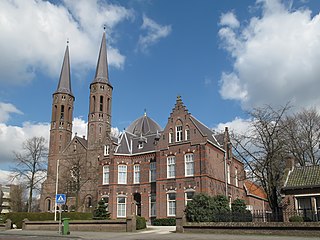
Maashorst is a municipality in the south of the Netherlands, formed from the merger of Landerd and Uden. The municipality came into existence on 1 January 2022. The name Maashorst refers to the nature reserve of the same name, which lies between the various village centres. The eastern part belongs to the region of De Peel.






















